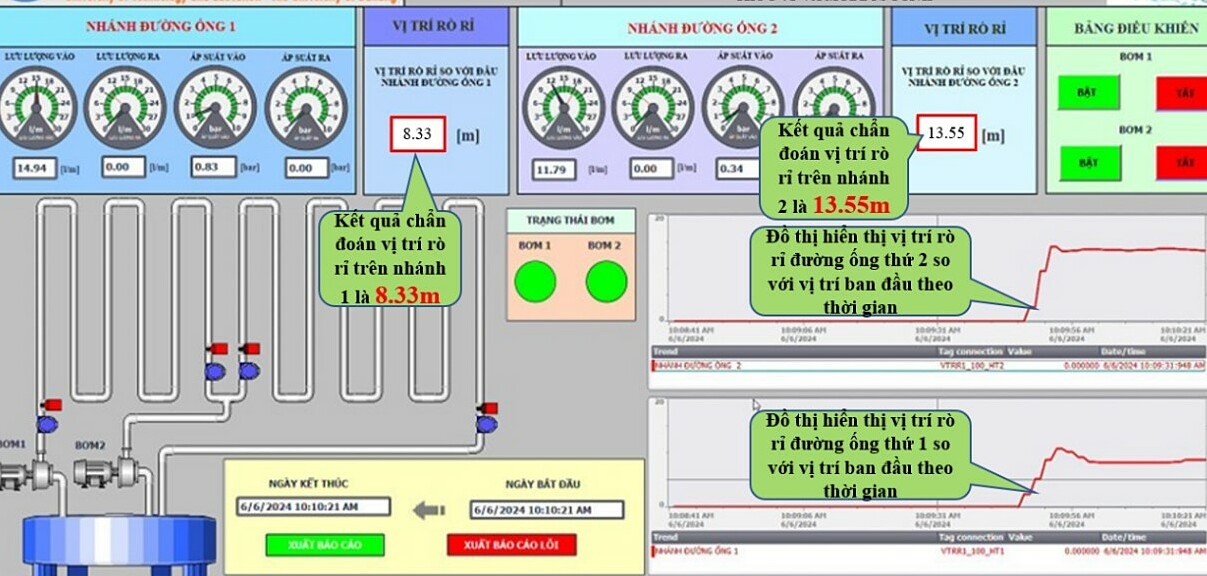4G technology applied to prevent water loss
To help the water pipeline system operate economically and effectively, a group of students from the Faculty of Electronic and Electrical Engineering of the University of Technical Education - the University of Da Nang have proposed a number of solutions from 4G technology such as using sensors, ultrasonic waves and applying state observation algorithms to accurately diagnose the location of water leaks.
 |
| Interface of the software for managing water leaks in pipelines built by the group of Da Nang students. Photo: H.L |
After nearly 2 years of surveying and finding solutions from 4G technology, Duong Thi Thanh Ha, a representative of the group, said that most users currently find the location of water leaks with the naked eye. This method takes a lot of time and is even ineffective because many pipelines are buried deep underground or located in difficult-to-observe locations. In this case, a modern sensor system will help people detect the smallest changes in water flow and pressure.
“By placing sensors at key locations on the pipeline, the system can collect data on flow and pressure as well as detect abnormalities when a leak occurs. In addition, ultrasonic technology supports signal transmission, helping to accurately measure deformation and damage in the pipeline to determine the location of the leak without having to inspect it directly” Ha added.
During the research process, the group of students designed a 40m long pipeline divided into 2 branches, with sensors attached at both ends. Also, valves were arranged along the pipeline to simulate the phenomenon of leakage.
Nguyen Quang Vinh, a team member, noted that to assess the feasibility, the group measured the distance from the valves to the beginning of the pipeline to compare with the estimated leak location from the algorithm.
Designed by the team, the system for diagnosing multiple leaks in water pipes and adjusting the output pressure via a 4G network includes hardware with flow and pressure sensors mounted at both ends of the pipeline branch that needs to be monitored, along with a control center located far from the pipeline.
These sensors are responsible for collecting data related to water flow and pressure, then transmitting information to the centre via a 4G wireless network.
The team also developed software that integrates algorithms to process data from sensors to accurately determine the location of the leak. The software has an intuitive interface, displaying information about the location of the leak, water flow and pressure, making it easy for users to monitor and manage.
Thanh Ha said that when the system is operating, the sensors continuously send data to the monitoring centre via a 4G connection network. At the centre, an embedded computer will apply algorithms to analyze and diagnose the location of the leak. When there is an abnormal change from the sensor, the system immediately sends a warning signal to the application, helping the operator quickly detect and handle the problem.
In the coming time, to improve the efficiency of use, the student group aims to research and apply artificial intelligence to build mathematical models for more complex pipeline systems. This model considers uncertain components such as pipe wear, and water flow friction to give more accurate results.
Dr. Pham Thanh Phong, lecturer at the Faculty of Electrical and Electronic Engineering, commented that this research direction brings great potential for the development of anti-water loss technology in the future.
According to Dr. Phong, the group's project is currently at the testing stage on the model, and there are no conditions to invest in experiments in the city's actual pipeline system.
"In my opinion, this system is suitable for installation in general water pipes. In fact, many units have now set up sensor systems mounted on the pipeline network to manage water supply data. Therefore, the software built by the student group can be applied immediately if approved by water management agencies," Dr. Phong affirmed.
| Thanks to providing sustainable solutions to protect water security, the project "Research on multi-location leak diagnosis algorithm in water pipes and adjusting output pressure via 4G network" by a group of students from the Faculty of Electricity and Electronics Engineering of the University of Technical Education won first prize in the "Da Nang University’s Scientific Research Contest for Students in the 2023-2024 school year". The project was highly appreciated by the jury members for its feasibility. |
Reporting by HUYNH LE - Translating by M.DUNG








